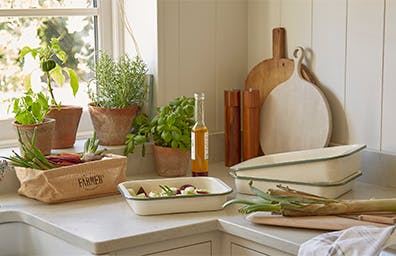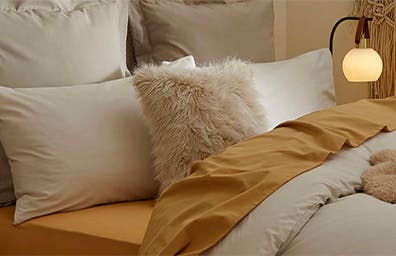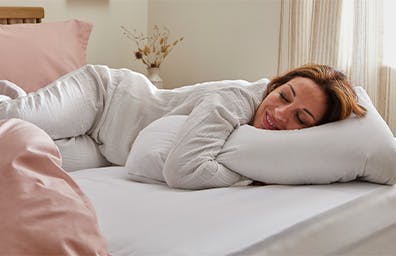6 decluttering and organising tips for your home
There are so many advantages to having a proper sort-out of your possessions. Decluttering your house is great for your mental health, will help your home feel more spacious and you might even rediscover things you thought were long gone (like that beloved jumper or family photo albums). It’s worth organising and tidying while you’re decluttering, and we have lots of clever storage suggestions to help you get the most out of your belongings and your home.
As declutterer extraordinaire Marie Kondo said: “Tidying, in the end, is just a physical act. The work involved can be broadly divided into two kinds: deciding whether or not to dispose of something and deciding where to put it. If you can do these two things, you can achieve perfection.” So, here are 6 strategies to help your home feel more ordered and tranquil…
1. Declutter and organise your clothing & shoes
Wardrobes and drawers are ideal for the clothes you wear regularly, but it can be a tight squeeze and hard to locate things without a bit of management. First off, take everything out and create three piles.
- Pile one: everyday keepers. It makes sense to house the garments you wear all the time within easy reach so pop these into easily accessible storage.
- Pile two: seasonal keepers. You get your wear out of these when the time - and weather - is right, e.g. partywear, bikinis and bulky layers. You won’t be reaching for these all year round, so pack them away when they’re not needed. Think under-bed drawers and boxes, storage on top of wardrobes, in the loft etc.
- Pile three: the goodbye pile. The bits that no longer fit, don’t suit your style or are otherwise going unworn and unloved. These can be donated, swapped, resold or recycled.
Regardless of any ‘what ifs’ lingering in your mind, you’re unlikely to miss your goodbye pile. If you struggle to sever those ties, you can prove to yourself that you don’t and won’t wear everything currently sitting in your wardrobe by noting if it gets an outing. Start with all your hangers facing one way, and turn each one round once you’ve worn the item. Within a few weeks you’ll have an idea of which pieces you’re wearing regularly, and which you’re not.
Once you’ve streamlined your wearables, it’s time to sort them. Make the most of smaller spaces by using hangers that hold multiple items or pack larger items in clear storage boxes and place them under your bed or on the floor of your wardrobe. That way you can easily see what’s in them. Place hooks on the back of your wardrobe doors to hang ties and hats. For drawers, rolling your smaller items of clothing will free up space - you can then organise them by type using adjustable dividers. Shoe storage is a smart way to save even more precious space - shoes can be arranged in over-the-door shoe hangers or in tiered shoe racks so you can easily grab them as you’re running out the door.
2. Sorting & grouping kids’ toys
Toys, while wonderful for children, don’t always have the same appeal for parents — especially when they’re all over the floor. Give unloved or out-grown games a new life by donating old toys to charities (refuges, care homes, libraries and children’s hospitals might all be able to make use of good-quality toys and games), to charity shops or just to friends with younger children.
If you’re not sure what to get rid of, you can start by asking these simple questions -
- Is there anything broken?
- Is there anything that isn't played with?
- Is there anything that doesn't fit the space?
- Are there multiples of the same/similar toy/object?
Once you’ve edited the toy collection, it will be easier to organise them effectively. Toys need storage that involves minimal effort as they’re likely to be tipped out and tidied away again at regular intervals; toy boxes and toy chests make ideal one-stop storage solutions as they’re large enough to hold lots of toys. Group like with like, for example cars, dolls, and games, and set up a craft table or box to keep all their colouring and artwork materials together. If you’re feeling really organised, labelling toy boxes and baskets with a picture and the name of what’s inside not only will help keep things tidy but can aid little ones with reading and writing skills too. Tilted bins are a smart choice as little ones can easily see what’s inside and – if you’re really lucky – they may even help with the tidying up, while toy hammocks are a fantastic way to store cuddly toys and utilise wall space.
3. Organise your books creatively
Overrun with your favourite reads? Start with a sort-out: is there anything you can’t see yourself ever re-reading? Do you have multiple copies of anything? Give unwanted books to charity shops, have a book sale on your front drive or host a ‘book swap’ with friends (you all bring a couple of reads you’d recommend and swap with each other, leaving you with a bit less clutter and more great reading material. Win win!)
Freestanding vs Fitted Bookcases
Once you’ve got your narrowed down selection, where to put them? A bookcase is an obvious solution, but should you go freestanding or fitted?
Freestanding offers more scope if you plan to move house or change furniture around regularly, but fitted bookcases utilise space more efficiently and make a great focal point in your room, too.
Bookshelf alternatives
Also, who says bookshelves are the only way? If you’re short of space or simply have too many favourites, there are plenty of other creative solutions. You can stack them in unconventional places like inside unused fireplaces, on windowsills, on decorative ladders or beneath benches.
Fancy making a little library of your own? Start by taking note of any nooks and crannies in your home that aren’t living up to their full potential. Ledges that run around the top of your staircase, for example, are a great place to decoratively stack already-read books. Or what about the walls surrounding your doorways? They’re often under-utilised and can offer a unique place to fit shelves - especially handy if you live in a smaller space. Awkward storage areas can also become an unconventional haven for books, like those skinny cupboards in your kitchen or that empty space behind your bedroom door (opt for a narrow bookcase that’ll slip in unnoticed ’til the door’s closed).
4. Store your jewellery in a box or on a tree
Similar to your wardrobe, the best way to declutter jewellery is to take note of what you wear. You’re likely to have pieces you reach for every day, and then a selection of bits that have sentimental value or that you save for special occasions. Anything leftover that's not regularly worn and doesn’t give you the warm fuzzies? Take it to a charity shop or add it to the pile for selling online, so it can make somebody else sparkle.
Now you’ve decluttered, it’s time to find a storage option that lets your favourite pieces really shine. Organising your jewellery properly won’t just save you from that rage-inducing detangling anytime you want to wear a necklace. It’ll help keep your jewellery safe and looking its best for as long as possible, too. Did you know that fine jewellery needs to be kept at room temperature, away from direct sunlight and preferably somewhere with low humidity to avoid tarnishing the metal?
Jewellery boxes vs. Jewellery trees and stands
Jewellery boxes are the most traditional way to do that, but if you want to show off your collection, there are lots of ways to store and display your bracelets, bangles and rings. Earring trees and necklace stands, for example, are ultra-popular because they keep things organised while acting like an ornament in their own right, while ring dishes are an easy-yet-effective way to keep smaller bits of jewellery safely stored and within easy reach.
5. Categorise your paperwork
Bills, bank statements and birth certificates – they all need to be kept organised, safe and preferably out of sight. It’s worth doing an annual sort-out of your paperwork to manage it and, if at all possible, reduce it.
To declutter, ask yourself three questions:
- Do I need this info within easy reach?
- Can I get it online?
- Do I have another copy somewhere else already?
If you decide there’s something you don’t need, put it in the recycling or through the shredder if it’s sensitive information. With whatever’s left, arrange it into simple categories - you might use something like these:
- Household bills
- Medical info
- Finances: Mortgage and bank statements, pension info and things like paper payslips and/or P60s and P45s
- Personal: Think passports, NI cards and birth and marriage certificates
- Sentimental: If you can’t bear to part with the kids’ old drawings or all those birthday cards
Once you’ve got your categories sorted, it’s time to get labelling - and colour coding is a good idea, too.
As for office storage? Don’t let the phrase ‘filing cabinet’ fill you with fear (stay with us). Forget drab-office grey; there are plenty of great, aesthetically pleasing cabinets that come in colours to suit any space. But if you just don’t have the room, accordion folders are an easy - and space-saving - way to keep things separated and organised. And you can keep them out of sigh (but within easy reach) in any cupboard.
6. Assess your bathroom space before organising
Shampoo bottles, razors, face creams, towels and flannels… finding a place for them all in the bathroom is no easy task, as it’s often the smallest room in the house. Get creative and look for bathroom storage in places you might usually not think of.
Start by looking at the space you have and assess how you can use it better.
- Can you get an over-the-door hanger for towels?
- Is there room for an under-sink storage unit?
- Could your bathroom mirror double up as a wall cabinet?
- What about the space above the toilet itself? Could you fit a wall cabinet?
Once you’ve assessed the space you have, you can now edit what you have. If there are toiletries you know you won’t use you could donate them (think: those gift sets from well-meaning Great Aunty Jan). Or if you’ve bulk-bought essentials and don’t have the space, place the extras in a basket or box and store them in a wardrobe or cupboard - or even the loft.
Bottles of shampoo and shower gel can leave unsightly sticky marks on the sides of the bath or the floor of the shower, so use the space inside a shower or above a bath for a shower caddy to store them. This allows them to be kept neat and out of the way, while still giving you easy access.






